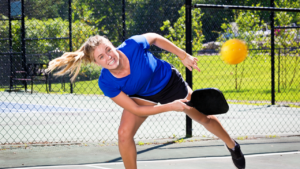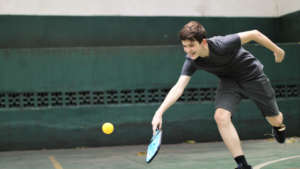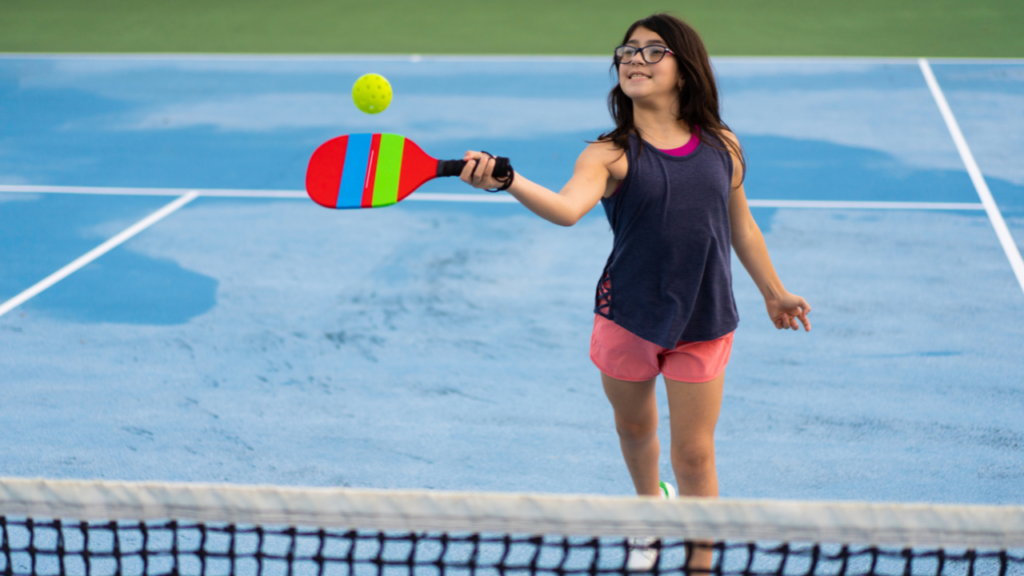
Did you know that over 4.8 million people play pickleball in the U.S. alone? The pickleball lob shot is a game-changer for players looking to up their skills. This technique can help you gain an edge on the court and keep your opponents guessing. Mastering the lob shot adds variety to your game, making it more exciting and unpredictable.
Whether you’re a beginner or a seasoned player, understanding when and how to use this shot can elevate your gameplay. In this post, we’ll dive into the essentials of the pickleball lob shot, including tips and tricks to perfect it. Get ready to impress your friends and dominate your next match!
Table of Contents
Key Takeaways
- A lob shot is a high, arching shot used in pickleball to surprise your opponent and gain an advantage.
- There are different types of lob shots, including defensive and offensive lobs; knowing when to use each can improve your game.
- Use a lob shot when your opponent is near the net or when you need to reset the point.
- Benefits of lob shots include creating space on the court and forcing opponents to move back, which can lead to mistakes.
- To execute a lob shot effectively, focus on your paddle angle and follow through for better height and distance.
- Practice countering lob shots by positioning yourself well and anticipating where the ball will land.
What is a Pickleball Lob Shot
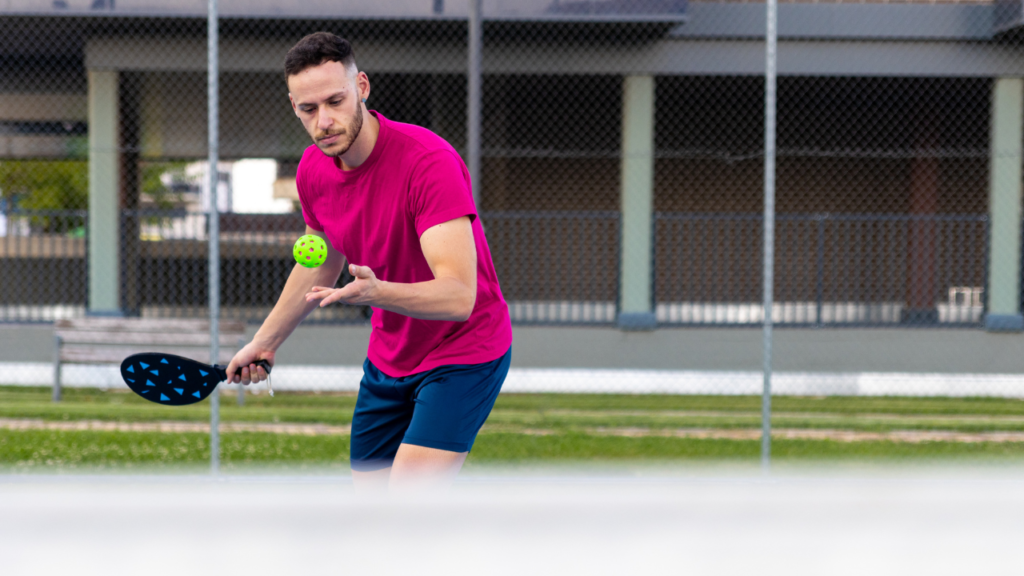
Definition
A pickleball lob shot is a high-lofted shot. Players aim it over their opponent’s head. This shot helps disrupt an opponent’s positioning. It forces them to move back, creating space on the court.
Many pickleball players use this technique during games. The lob can be offensive or defensive. An offensive pickleball lob targets an opponent who stands too close to the net. A defensive pickleball lob is used when a player needs time to recover.
Strategic Purpose
The strategic purpose of a lob shot is clear. It creates both space and time during a rally. A well-timed lob can shift the momentum of a game. It allows players to regroup and plan their next move.
Professional pickleball players often use lobs effectively. They catch opponents off-guard with unexpected shots. This breaks the rhythm of the game and puts pressure on the opponent. A successful pickleball player knows when to use this powerful strategy.
Execution Tips
Executing a pickleball lob requires practice. Players should focus on their paddle angle and follow-through. The right technique ensures the ball goes high enough to clear the net and land in bounds.
Easy pickleball drills can help improve lob shots. Practicing with a partner or against a wall builds confidence. Players should also try different angles and heights for their lobs.
Importance in Defense
Defensive pickleball lobs are crucial in tight situations. They provide a chance to reset after being attacked. When under pressure, a well-placed lob can turn the tide.
Pickleball lob defense tips include watching your opponent’s position closely. Anticipating their next move helps determine when to lob. A good defense often leads to successful counter-attacks.
Catching Off-Guard
Catching opponents off-guard is one of the key benefits of a lob shot. Many players expect quick, low shots. A sudden high shot can disrupt their strategy.
Players must be aware of their surroundings when using lobs. Recognizing when an opponent is out of position increases success rates. Breaking an opponent’s rhythm can lead to mistakes and easy points.
Types of Lob Shots

Offensive Lobs
Offensive lobs are used to attack the opponent. Players often hit these when they see their opponent close to the net. The goal is to send the ball over their head and land it deep in the court. This forces opponents to run back, giving you time to take control of the point.
Defensive Lobs
Defensive lobs come into play when players are under pressure. These shots help players regain their position on the court. They can lift the ball high and deep, allowing time to reset. A well-timed defensive lob can change the momentum of a match.
Deep Lobs
Deep lobs travel far into the opponent’s side. They aim for the baseline, making it hard for opponents to return. Players use deep lobs when they want to push their opponents back. This strategy creates space at the net for follow-up shots.
Short Lobs
Short lobs are different from deep lobs. They land closer to the net. Players often use short lobs to catch opponents off guard. These shots can be effective when opponents are positioned too close to the net. A well-placed short lob can lead to an easy point.
Spin Techniques
Adding spin makes lob shots more challenging for opponents. Players can use topspin or backspin on their lobs. Topspin causes the ball to dip quickly, making it harder to return. Backspin keeps the ball low and slows its movement after bouncing.
Game Situations
Different game situations call for different types of lob shots. For example, during a fast-paced rally, a player might need a quick offensive lob. In contrast, when facing a strong opponent, a defensive lob may be necessary. Understanding when to use each type can improve overall gameplay.
Incorporating Methods
Several methods exist for executing effective lob shots. Players should practice their timing and angles consistently. Good footwork also plays a vital role in making accurate lobs possible. By mastering various techniques, players can enhance their skill set.
Key Things to Remember
Know your opponent’s position: Observe where your opponent stands before choosing your shot.
Practice different spins: Experiment with topspin and backspin during training sessions.
Choose the right moment: Wait for an opening before attempting offensive or defensive lobs.
When to Use a Lob Shot
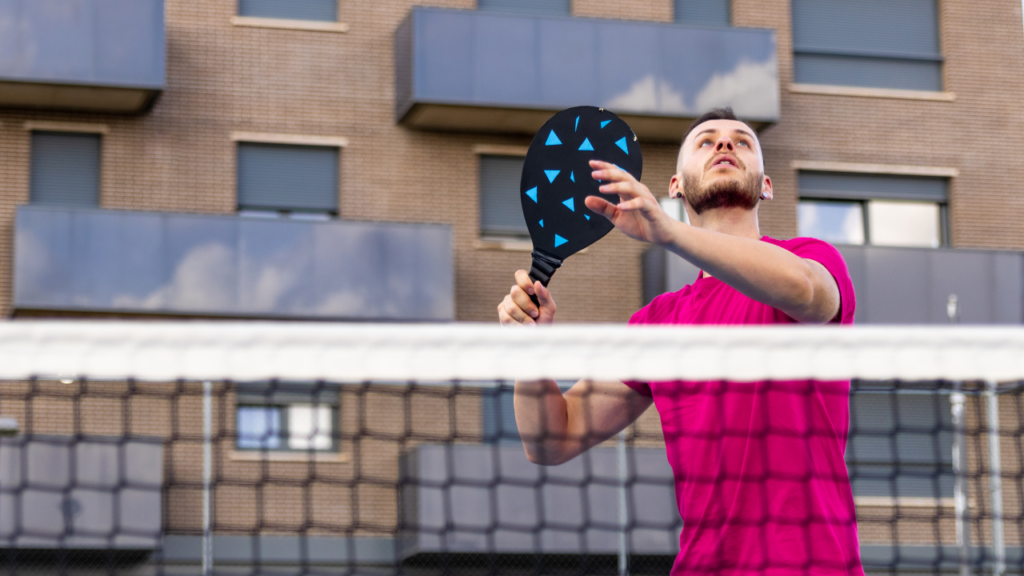
Close Opponents
A lob shot is useful when opponents are too close to the net. This situation often happens during fast exchanges at the kitchen line. Players may feel pressure to hit hard shots. Instead, they can surprise their opponents with a well-timed lob.
Lobbing over an opponent can force them to retreat. It gives players time to regain control of the point. If the opponent is at the net, they might not expect a high shot. This makes it harder for them to respond effectively.
Assess Positioning
Before hitting a lob shot, assess your opponent’s position. Is your opponent standing close to the net? Are they leaning forward? These factors influence whether a lob will be successful.
If the opponent is off balance, a lob shot can catch them off guard. A well-placed lob can land deep in their court. This forces them to move back quickly. They may struggle to return it if they are not prepared.
Change Game Pace
Using lob shots strategically can change the pace of the game. Players can mix up their shots to keep opponents guessing. Consistent hard shots can become predictable. A sudden lob can disrupt this rhythm.
Players should practice using lobs during matches. They should aim for areas where opponents are least likely to reach. This includes targeting corners or deep areas of the court.
Timing Matters
Timing is crucial when executing a lob shot. Wait for the right moment when your opponent is out of position. A good time might be after a strong rally or when they miss a shot.
Players can also use lobs as defensive shots. If they find themselves in trouble, a quick lob can buy them time. It allows them to reset and prepare for the next shot.
Practice Makes Perfect
Practicing lob shots helps improve accuracy and timing. Players should work on both forehand and backhand lobs. They must ensure that their lobs have enough height and depth.
Incorporating various types of lobs into practice sessions builds confidence. This prepares players for real-game situations where they need to use them effectively.
Benefits of Using Lob Shots

Create Opportunities
Lob shots can create opportunities during a game. They force opponents to move back. This movement can open up the court for other shots. For example, when an opponent is pushed to the back line, they may struggle to return a quick follow-up shot. Players can take advantage of this by hitting a drop shot or a powerful drive.
Using lob shots often keeps opponents guessing. They cannot predict where the ball will go next. By mixing in lob shots, players maintain control over the pace of the game. A well-timed lob can change the momentum. It can surprise opponents and shift their focus.
Psychological Advantage
The psychological aspect of using lob shots is significant. Mixing up shot types keeps opponents on their toes. They must constantly adjust their positioning and strategy. This uncertainty can lead to mistakes. When players feel pressure, they may rush their shots or misjudge distances.
For instance, if players rely solely on hard drives, their opponents may become comfortable with that style. Introducing lob shots disrupts this comfort zone. Opponents must think twice before making their next move. This mental challenge can be just as important as physical skill in pickleball.
Lead to Unforced Errors
Effective lobs can lead to unforced errors from opponents. When players are caught off guard, they might mishit the ball. A well-placed lob can make them overshoot or hit into the net. These mistakes often happen when players feel rushed or pressured.
Players can also exploit weak returns from lob shots. If an opponent struggles to handle a high ball, they may return it poorly. This creates opportunities for easy points. In competitive play, capitalizing on these errors can make a big difference in the score.
In summary, using lob shots offers many benefits in pickleball. They create opportunities by forcing opponents back and keeping them guessing. The psychological advantage gained from mixing shot types is crucial for success. Finally, effective lobs often lead to unforced errors from opponents, providing further chances to win points.
How to Execute a Lob Shot

The Perfect Pickleball Lob Shot
Step 1 - Grip and Stance
A proper grip is crucial for a successful lob shot. Hold the paddle with a firm grip. Your fingers should wrap around the handle comfortably. Keep your wrist relaxed for better control.
Next, position your feet shoulder-width apart. This stance provides balance and stability. Bend your knees slightly. This helps you stay low and ready to move. Make sure to keep your body weight on the balls of your feet. This allows for quick movements toward the ball.

Step 2 - Movement Mechanics
Use your legs to generate power in your lob shot. Start by bending your knees more as you prepare to hit the ball. Push off with your legs as you swing the paddle. This motion adds strength to your shot.
As you swing, rotate your hips and shoulders together. This movement creates momentum. Follow through with your paddle after contact with the ball. Aim to hit the ball at its highest point for maximum lift.

Step 3 - Target Area
Landing the lob shot in the right area is key to its effectiveness. Aim for the back corners of the court. This makes it difficult for your opponent to return the shot.
Consider using the kitchen line as a guide. Hitting just over this line can force your opponent back, giving you an advantage. A well-placed lob shot can create space on the court.
Practice targeting different spots during training sessions. The more you practice, the better you’ll become at placing your shots accurately.

Tips for Successful Lob Shots
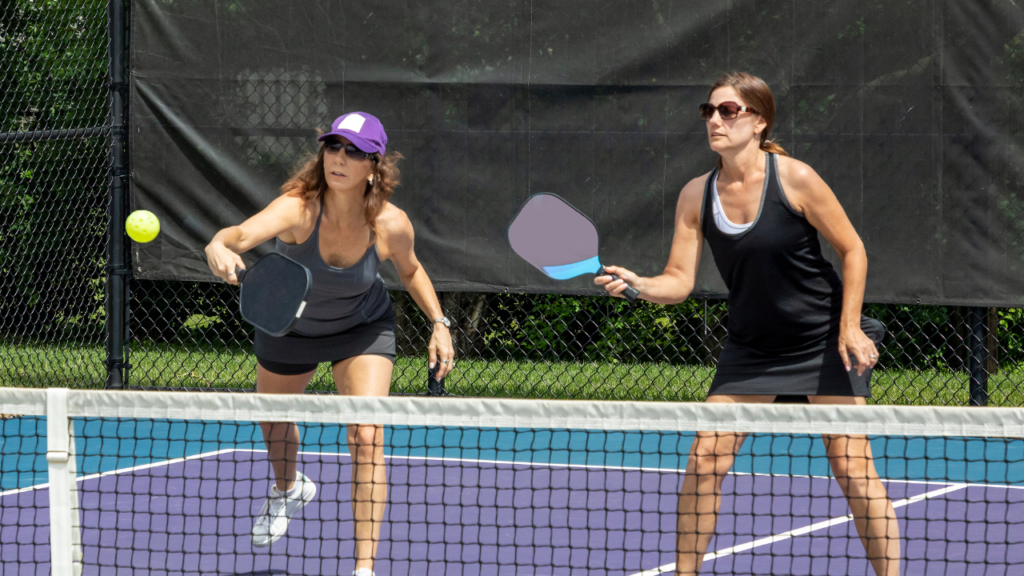
Practice Control
Players must practice touch and control to improve lob shot accuracy. A successful lob requires a gentle touch. This means hitting the ball softly enough to clear the net but not too hard that it goes out of bounds. Practicing with a partner can help develop this skill. Players should aim for different heights and distances during practice sessions.
Incorporating drills that focus on soft shots will also enhance control. For example, players can stand close to the net and practice lobbing over their partner’s head. This helps in developing a feel for the ball. The more players practice, the better their lob shots will become.
Focus on Timing
Timing is crucial when executing an effective lob shot. Players need to watch the opponent’s movements closely. If an opponent is rushing towards the net, it may be a good time to use a lob shot. Proper timing minimizes errors and increases the chances of success.
Players should also focus on their own footwork. Being in the right position allows for better shot placement. When players are balanced, they can generate more power and accuracy in their lobs. Practicing footwork drills can help improve this aspect of the game.
Observe Opponents
Observing opponents’ positions is vital for determining the best moments for lobbing. Players should pay attention to where their opponents stand on the court. If an opponent is too close to the net, a well-placed lob can catch them off guard.
Players can look for opportunities when opponents are out of position or distracted. This often happens during rallies when players are focused on returning shots. A quick glance at an opponent’s stance can provide valuable information about when to execute a lob shot.
Use Effective Methods
Using effective methods can lead to successful lob shots. One method is to aim for specific areas of the court. Targeting deep corners makes it harder for opponents to reach the ball. Another method involves varying shot heights. Mixing high and low lobs keeps opponents guessing.
Players should also consider using spin on their lob shots. Adding topspin can make the ball drop quickly after crossing the net. This technique adds another layer of difficulty for opponents trying to return the shot.
Stay Calm Under Pressure
Staying calm under pressure is essential during matches. Players might feel anxious when attempting lob shots in crucial moments. Taking a deep breath can help maintain focus.
Practicing under match-like conditions can also build confidence. Simulating game scenarios allows players to experience pressure without the stakes being too high. This practice helps players remain calm when it counts.
Countering Lob Shots
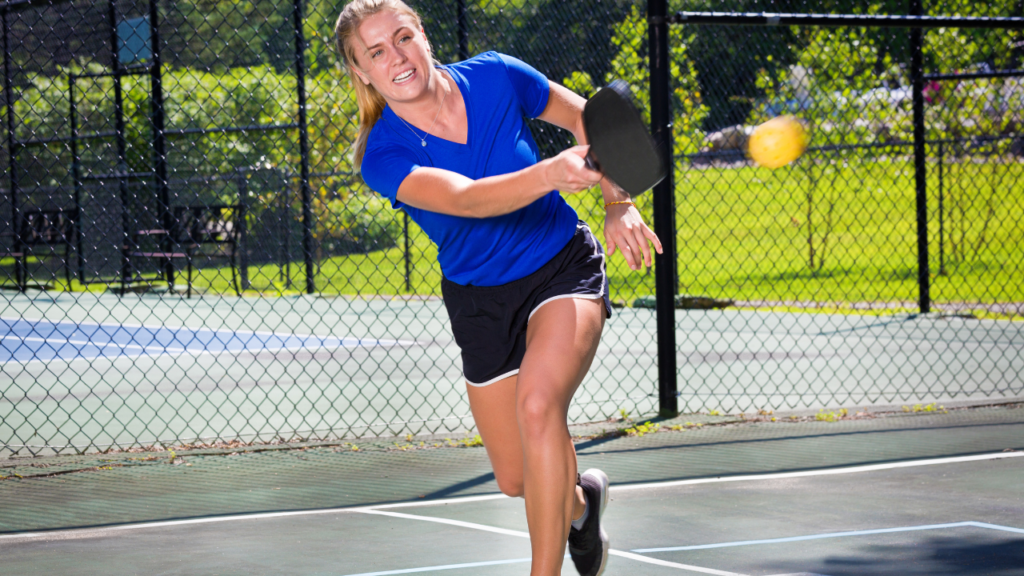
Smashing Technique
Players can effectively counter a lob shot by using an offensive lob technique. This involves timing and positioning. Stand slightly behind the baseline when you see the lob coming.
Use a hammer grip to create power in your shot. Keep your eyes on the ball as it descends. As it gets closer, prepare for a strong swing. A minimal backswing helps generate quick momentum. Focus on hitting the ball at its highest point. This gives you the best angle to smash the shot back.
Aiming for deep shots can pressure opponents. Target their corners or the back of the court. These spots are harder to reach and return. Practice this technique regularly to improve your confidence and accuracy.
Drop Shot Advantage
Using a drop shot can be an effective counter to a lob. When opponents hit a lob, they often expect a powerful return. Instead, surprise them with a soft drop shot. This tactic disrupts their rhythm.
The drop shot keeps opponents on their toes. It forces them to move quickly toward the net, which can create openings. If they are caught off guard, they may struggle to respond effectively.
This strategy works especially well if the opponent is napping or not ready for a quick change in pace. Players should practice their drop shots to ensure precision and control. A well-placed drop can win points easily.
Avoiding Another Lob
Responding with another lob may not be wise. This can give your opponent an advantage, especially if they are skilled at returning lobs. They could anticipate your move and position themselves accordingly.
Instead of lobbing back, consider alternative shots like a defensive shot or an aggressive smash. These options allow you to regain control of the game. Hitting a strong offensive shot can keep pressure on your opponent.
Remember that each situation is unique. Assess your opponent’s position and strengths before deciding how to respond. Relying solely on lobs might leave you vulnerable.
Understanding Lob Serves
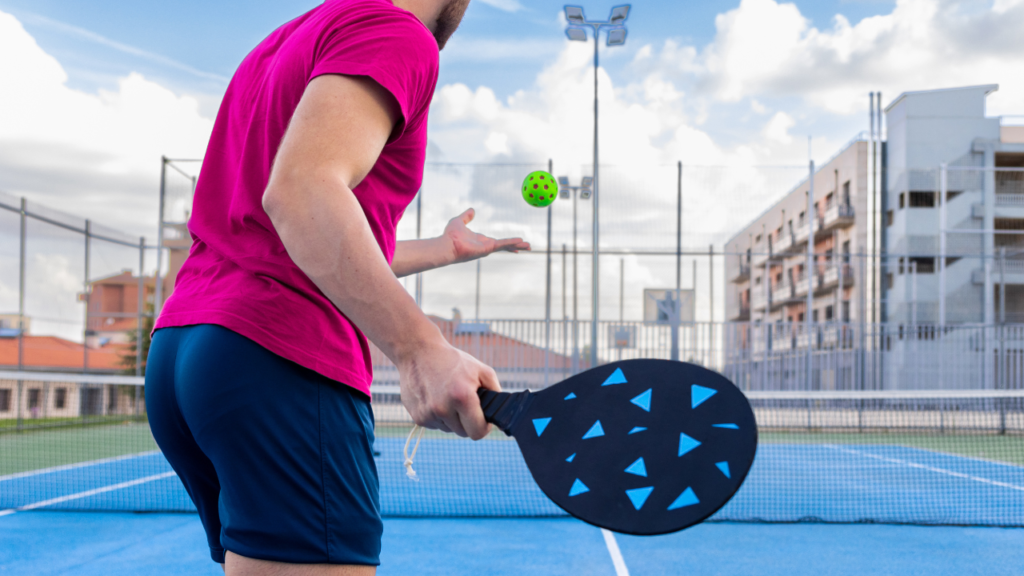
Definition
A lob serve is a type of shot in pickleball. It sends the ball high into the air, aiming to land deep in the opponent’s court. This shot differs from a traditional serve, which typically travels straight and low. The lob serve gives players more time to prepare for their next move.
Strategic Benefits
Using an effective lob serve can surprise opponents. Many players expect fast and direct serves. When they encounter a lob, they might be caught off guard. This unexpected height can create openings in their defense. It forces them to adjust quickly, often leading to mistakes.
Players can also use the lob serve to control the game. By varying shot types, they keep opponents guessing. A well-timed lob can change the pace of play. It can shift momentum and give players an advantage.
Importance of Height and Placement
Height is crucial when executing a lob serve. The ball should go over your opponent’s reach but still land within the court boundaries. A high shot makes it difficult for opponents to attack effectively.
Placement is equally important. Aiming for the corners or deep areas of the court creates challenges for your opponent. If the ball lands near the baseline, it forces them to move back. This movement can lead to errors or weak returns.
To execute an effective lob serve:
Focus on trajectory: Aim high enough to clear your opponent.
Target specific areas: Place the ball where it’s hard for them to return.
Practice consistently: Regular practice helps improve accuracy and height.
In summary, mastering the lob serve adds depth to a player’s skill set in pickleball. Players who understand its unique characteristics can use it strategically against opponents. By focusing on height and placement, they can turn this shot into a powerful weapon during matches.
Returning High Lob Serves

Positioning Strategy
Positioning is key when returning a high lob. Players should stand near the volley line. This helps to anticipate the ball’s landing. A good position allows for better angles when hitting the return. Players can also take a low squat to prepare for the incoming shot. This stance helps maintain balance and readiness.
Players need to watch the opponent’s paddle movement. A predictable serve often leads to a high lob. Recognizing this can give players a split-second advantage. They can then move quickly to the right spot on the court.
Timing and Footwork
Timing is crucial in making successful returns. Players must track the ball closely as it comes down. The high floaty ball can be tricky, but with practice, timing improves. Good footwork helps players get into position faster.
Players should focus on their steps. Quick side-to-side movements allow them to adjust their stance. Using small, quick steps keeps them balanced and ready for the next volley. Practicing these movements builds muscle memory.
Combining Techniques
Combining volleys and groundstrokes can counter high lob serves effectively. Players should consider using a volley for immediate returns. This technique allows for a powerful volley opportunity right after the lob lands.
Groundstrokes can also be effective if players are positioned well. A strong groundstroke can send the ball back with speed and accuracy. It’s important to aim for deep shots that push opponents back.
Players may also vary their returns. Mixing up volleys and groundstrokes keeps opponents guessing. This unpredictability can lead to mistakes from the other side of the net.
Practice Drills
To improve skills, players should practice specific drills. Here are some examples:
Lob Returns: Practice returning high lobs from different positions.
Footwork Drills: Set up cones to work on quick movements.
Volley vs Groundstroke: Alternate between volleys and groundstrokes during practice matches.
These drills help build confidence in returning high lobs effectively.
Final Remarks
Mastering the pickleball lob shot can elevate your game. You’ve learned what it is, the types, and how to execute them. Understanding when to use a lob shot and how to counter it gives you an edge. Plus, knowing the benefits helps you make smart choices on the court.
Now it’s time to practice! Get out there and incorporate lob shots into your play. Experiment with different techniques and strategies. The more you practice, the better you’ll become. Share your experiences with others and keep improving together. Your skills will shine, making you a formidable opponent. Let’s hit those courts!
Frequently Asked Questions
A pickleball lob shot is a high, arching shot intended to send the ball over your opponent’s head. It creates distance and can catch opponents off guard, making it a strategic move in gameplay.
Use a lob shot when your opponent is at the net or when you need to reset the point. It’s effective for gaining time and space, especially if you’re under pressure.
Lob shots can disrupt your opponent’s positioning, create opportunities for winning points, and allow you to regain control of the game. They also help in defensive situations.
To execute a lob shot, use an open paddle face, aim high, and apply a gentle upward swing. Focus on your follow-through to ensure accuracy and height.
Yes, you can counter a lob shot by positioning yourself quickly under the ball and either smashing it back or setting up for a volley. Anticipation is key.
High lob serves are serves hit with an arc that lands deep in the opponent’s court. They can be challenging to return and are useful for keeping opponents guessing.
To return high lob serves, position yourself early and prepare for an overhead smash or a controlled volley. Timing and footwork are crucial for effective returns.

